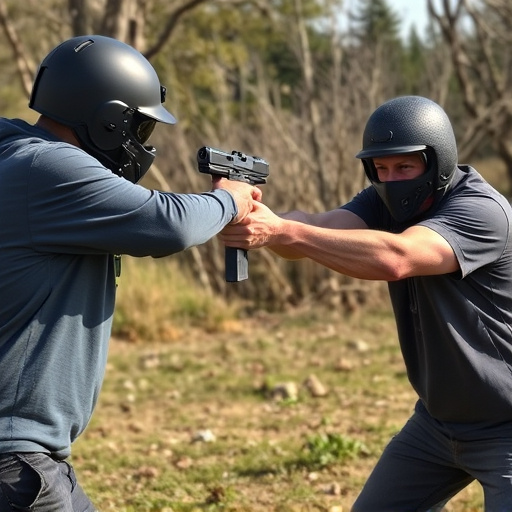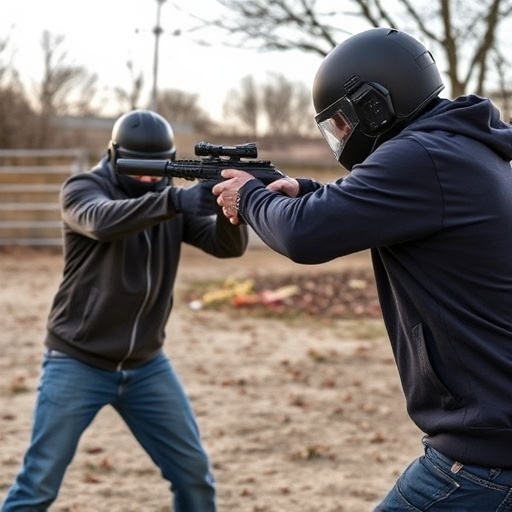Understanding basic electricity is crucial for grasping how affordable stun guns work. These devices use Direct Current (DC) to deliver electric shocks that temporarily disable assailants through controlled voltage and current levels. Stun guns utilize high-voltage, low-current pulses generated by capacitors and resistors, minimizing energy waste and making them compact and effective for self-defense. Safety measures like protective gear and avoiding moisture are essential when handling these powerful tools, highlighting the importance of informed choices in personal protection through affordable stun guns for self-defense.
“Uncover the science behind electrical current flow in stun devices, essential knowledge for those considering affordable stun guns for self-defense. This article demystifies the fundamentals of direct current (DC) flow in electricity and its role in stun device functionality. We’ll explore how these tools convert energy into powerful shocks, delving into key components like batteries, wires, and electrodes. Additionally, we’ll discuss amperage, voltage, safety precautions, and provide insights for responsible ownership.”
- Understanding Basic Electricity: Direct Current (DC) Flow
- How Stun Devices Convert Energy to Shock
- Key Components: Batteries, Wires, and Electrodes in Stun Guns
- Measuring Current: Amperage and Voltage in Self-Defense Weapons
- Safety Precautions for Handling High Voltage Stun Devices
Understanding Basic Electricity: Direct Current (DC) Flow

Understanding basic electricity is crucial when delving into the world of stun devices, like affordable stun guns for self-defense. At its core, electricity revolves around the flow of charged particles, known as direct current (DC). This steady stream of electrons moves from a point of high electrical potential to an area of lower potential, generating heat and light along the way. In the context of stun devices, this DC flow is harnessed to deliver a powerful electric shock, temporarily disabling or disorienting an assailant.
By controlling the voltage and current levels, manufacturers are able to create safe yet effective tools for self-defense. The affordability of these stun guns makes them accessible to individuals seeking personal protection without breaking the bank. Understanding the fundamentals of DC flow allows users to appreciate the technology behind these devices, empowering them to make informed choices when it comes to their safety and security.
How Stun Devices Convert Energy to Shock

Stun devices, often considered affordable stun guns for self-defense, operate by converting electrical energy into a powerful shock. Inside these compact tools lies a sophisticated circuit designed to generate a high-voltage, low-current electric pulse. When activated, this pulse rapidly flows through wires to the output tip or probe, delivering a jolting force that temporarily disables an attacker.
The process involves a combination of components, including capacitors and resistors, which store and regulate energy. Upon activation, these components discharge, releasing stored energy in a controlled manner. This results in a powerful electric current that disrupts the attacker’s muscular control, causing them to lose balance or strength temporarily. The efficient design ensures that the shock is delivered with minimal energy wastage, making stun devices effective tools for self-defense while keeping them compact and lightweight for easy carrying.
Key Components: Batteries, Wires, and Electrodes in Stun Guns

Stun devices, commonly known as stun guns, are powerful tools for self-defense, offering a non-lethal way to incapacitate an attacker. The core components that make these devices effective lie in their simple yet robust design. At the heart of any stun gun are affordable batteries that power the electrical current flow. These batteries are crucial; high-quality, long-lasting batteries ensure reliable performance when it matters most.
The wires within a stun gun conduct the electric current from the battery to the electrodes. Strategically placed electrodes on the device’s surface allow for direct contact with an assailant. The wire connections and electrode design play a pivotal role in delivering a strong electrical shock, temporarily paralyzing the attacker without causing severe harm. When it comes to affordable stun guns for self-defense, understanding these key components is essential for choosing a reliable and effective device.
Measuring Current: Amperage and Voltage in Self-Defense Weapons

When evaluating the performance of stun devices, understanding electrical current flow is key. Measuring amperage and voltage offers insights into the device’s effectiveness as a self-defense weapon. Affordable stun guns for self-defense often advertise their power in joules, but it’s also crucial to consider the actual current delivery.
Amperage, measured in milliamps (mA), represents the rate at which electrical charge flows through a circuit. Voltage, measured in volts (V), signifies the pressure that drives the current. For stun devices, higher amperage and voltage generally translate to more intense shock, providing better protection in self-defense scenarios. Ensuring the device consistently delivers these levels is essential for effectiveness and safety.
Safety Precautions for Handling High Voltage Stun Devices

When handling high voltage stun devices, safety should be your top priority. These affordable stun guns for self-defense pack a powerful punch, but they also come with significant risks if not used properly. Always wear protective gear, including insulated gloves and eye protection, to minimize the chance of electrical shock or accidental discharge. Keep the device away from flammable materials and moisture to prevent short circuits and potential fires.
Never point or touch the stun gun to any metal objects or living beings. The high voltage current can travel through these paths, causing severe harm or even death. Ensure the device is turned off and unloaded before performing any maintenance or cleaning. Regularly inspect your stun gun for signs of damage or wear, replacing batteries promptly to maintain optimal performance. Proper handling and adherence to safety precautions are crucial to ensure your well-being while using these powerful self-defense tools.
Understanding electrical current flow is key when considering affordable stun guns for self-defense. By grasping how direct current (DC) works and its application in stun devices, users can appreciate the power they hold. Stun guns convert energy to deliver a shock through carefully designed components like batteries, wires, and electrodes. Knowing amperage and voltage helps ensure safe handling, as proper safety precautions are essential when dealing with high-voltage devices. Armed with this knowledge, individuals can make informed choices about personal protection while navigating the market for effective yet affordable stun guns.
